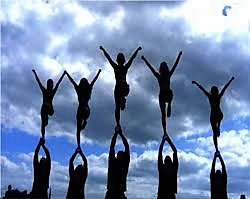Cheerleading discussed by Eastern Foot Care Dance Podiatrist Sarah Bowling
CHEERLEADING INJURIES

Cheerleading has evolved so much over the years. Beginning with basic organised chants, shaking pom poms and an occasional cartwheel to get the crowd fired up and involved at sporting matches to now
World Championship Competitions that involve different aspects of dance, gymnastics, acrobatics, stunts, tumbling, pyramids, lifts, flying and large explosive movements.
The rate of injury is very high especially for head and neck. However, the lower limb including ankles, knees and feet are next in line for most common injuries in Cheer.
Ligament sprains account for 20% of all cheer injuries, strained muscles 14% and Fractures account for 10%. With the growing popularity of this sport in Australia we as clinicians are starting to see these complex injuries presenting at our clinics for treatment, management and rehabilitation.
Ankle sprains
Commonly occur by landing off balance/incorrectly out of jumps and tumbling, landing on the edge of the mat or by stepping on a team mate’s foot. The foot becomes ‘inverted’ which means that the sole of the foot ends up facing inwards and causes a strain or tear of the outside ankle ligaments. Often a pop sounds is heard or felt.
team mate’s foot. The foot becomes ‘inverted’ which means that the sole of the foot ends up facing inwards and causes a strain or tear of the outside ankle ligaments. Often a pop sounds is heard or felt.
Depending on the force and the angle that the injury occurred at will depend on the severity
A Grade 1 ankle sprain is where the ligaments have been stretched or minor tear has occurred. However, there will not be any laxity in the joint. A Grade 2 ankle sprain involves a partial tear of the ligament plus some laxity in the joint and finally a Grade 3 Ankle sprain is a complete rupture/tear of the ligaments and the joint will show a lot of laxity.
Most common ligaments that are damaged include- Anterior Talofibular Ligament, Calcaneofibular Ligament and Posterior Talofibular Ligament as shown on the diagram below. Ligaments on the medial side of the ankle can also be damaged with high stress injuries as they become crushed under pressure. Ligament damage higher up the ankle at the syndesmosis can also occur to the Anterior Inferior Tibiofibular Ligament.
The first 12 weeks after injury the risk of re-injury is the greatest therefore, a proper management plan is crucial. Depending on the severity of the ankle sprain Rest, Ice, Compression and Elevation (RICE) may be beneficial in conjunction with a Non-Steroidal Anti-Inflammatory Drug (NSAID) plus Physical Therapy and possibly an ankle brace for support.
In more serious Grade 3 cases crutches or a CAM Walker to immobilise can be utilised as well as imaging such as ultrasound, MRI or X-ray.
Long term, rehabilitation exercises will be prescribed by your Podiatrist to strengthen the ankle and prevent re-occurrence and possibly wearing a brace while playing for proper support. Repeated injuries or delayed treatment will lead to long term damage. It is the early recognition of the Grade of sprain coupled with proper management that will help the athlete return to activity faster and prevent the long term damage
Knee Injuries
Generally occur when the knee is extended past the normal straight range of motion position and becomes hyper extended. This can lead to dislocation, damage to the Anterior Cruciate Ligament (ACL) or cartilage tear. Cheerleaders often obtain knee injuries when performing their ‘Liberty Stunt’ as pictured
As a preventative, knee braces can be worn to limit the excess range of motion as well as other exercises which will improve stabilisation by strengthening surrounding structures such as Hamstrings, Calf muscles and Tibialis Anterior
With tumbling and particularly in a ‘layout’ it is as important to not land with locked legs as this will instantly tear the ACL.
Osgood Schlatters Disease of the knee is another common injury that goes together with Cheer. Interest in Cheerleading often spikes around high school/adolescent age as does the onset of Os-Good Schlatters. The tibial tuberosity and patella tendon become inflamed and a small bump develops just under the knee. Overuse, training errors and teenage growth spurts trigger this condition which will require management from a Podiatrist to prevent long term issues.
Foot
Stress Fractures of the metatarsals or toes can be common in Cheer. To perform a ‘standing double full’ requires a huge vertical leap and body awareness to be able to back flip and 360 degree twist in the air at the same time. On landing there is a great amount of force applied through the feet which can cause stress responses and fractures through the feet.
Prevention of injuries
Cheerleading associations have now implemented height restrictions in human pyramids, monitoring the number of spotters with lifts that go above shoulder height, appropriate mats for landing and cushioning, training courses for coaches and having a thrower flyer ratio. It is also very important for the team to keep warm and stretching during the inactive periods. For example- cheering at an outdoor football game in winter. There can be a lot of down time while waiting for the goal to be scored or half time entertainment routine to begin which can lead to muscle tears or ligament damage.
As well as all of the above seeking medical advice for previous injuries will prevent re-injuring.
Discuss Sports Injury Management with one of the Sports Podiatrists at Eastern Foot Care Podiatry Ringwood and Eastern Foot Care Podiatry Knox who can develop a management strategy to suit your presentation.
To make an appointment contact our friendly staff at:
Eastern Foot Care Ringwood
27 Wantirna Rd, RINGWOOD
Ph: (03) 9870 1301
Eastern Foot Care Knox
5a/426 Burwood Hwy, WANTIRNA SOUTH (Knox)
Ph: (03) 9887 2233